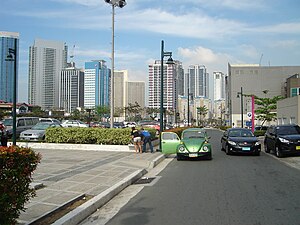 Image via Wikipedia
Image via Wikipedia
News reports of late have publicized the intention of many of the country’s corporate power players to put up
real estate investment trusts (REITs) to raise funds from the public. They include the Ayala and the SM groups, to name a few.
The law governing the REITs is Republic Act No. 9856 ("REIT Act of 2009 or REIT Law" or "law"), which lapsed into law last 17 December 2009. The policy underlying the law’s passage, as enunciated in Section 2, is to promote "the development of the capital market, democratize wealth by broadening the participation of Filipinos in the ownership of
real estate in the
Philippines, use the capital market as an instrument to help finance and develop infrastructure projects and protect the
investing public by providing an enabling regulatory framework xxx." A REIT is a stock corporation established under the rules of the Corporation Code of the Philippines principally for the purpose of owning income-generating real estate assets. Although designated as "
trust," it does not have the same technical meaning under existing laws.
The SEC’s IRR contain certain provisions which appear to be inconsistent with the provisions of the REIT Law. One important provision pertains to the limitations on the dividend distributions of REITs to public shareholders which will be the subject of this article.
Like all other
corporations, a REIT is allowed under the rules to have different classes of shares of stocks, as long as the same is provided in its Articles of Incorporation. However, the exercise of this power is subject to a unique limitation with respect to the percentage of
dividends allowed to public shareholders. Public shareholders are those shareholders that are not non-public shareholders (e.g. sponsor/promoter of the REIT; director, principal officer or principal stockholder of the REIT or its sponsor/promoter; associate of a director, principal officer or principal stockholder of the REIT or its sponsor/promoter of the REIT; a related corporation of the REIT or its sponsor/promoter)
Under the law, the percentage of dividends received by the public shareholders to the total dividends distributed by the REIT must not be less than the percentage of their aggregate ownership to the total outstanding shares of the REIT, as illustrated by the formula:
On the other hand, under the IRR, the percentage of dividends allowed to be received by the public shareholders is determined in reference to each class of stock and in an amount which should be at least equal to or more than the percentage of their aggregate ownership to the total outstanding shares of the REIT with respect to that particular class of stock. Thus, the formula under the IRR would be:
Under the IRR, public shareholders may receive a percentage of dividends which is less than their percentage aggregate ownership to the total outstanding shares of the REIT if the dividends are concentrated on other class of shares which is owned less by the public, contrary to the provision of the law.
Cleary, there is a need to harmonize the apparent inconsistency in the REIT Law and IRR provisions since there is a possibility that the application of the IRR provisions may be prejudicial to the public shareholders to the extent of diminishing or circumventing in any form their entitlement to dividends as provided under the REIT Law. Nevertheless, under this case, the IRR provisions would be rendered void and of no force and effect law as provided under the REIT Law.
Another issue that needs to be clarified is in respect to the mandatory dividend distribution provided under Section 7 of the REIT Law. Under this provision, a REIT is required to distribute at least 90% of its distributable income as dividends to its shareholders annually. Said distribution shall be allowed as a deduction for purposes of determining the REIT’s Taxable Net Income.
It will be noted further that while the 90% annual dividend distribution under Section 7 is mandatory, payment of said dividend is still subject to Section 43 of the Corporation Code which provides that dividends shall be payable only from out of the unrestricted
retained earnings of the REIT.
The relevant question now is what happens if the REIT’s unrestricted retained earnings are not sufficient to cover the required annual dividend distribution? Would the REIT still be required to declare dividends but payment shall be subject to the availability of unrestricted retained earnings at a later date; or will it be required to make a partial declaration; or will the absence of sufficient retained earnings be considered an exemption to the mandatory requirement?
Moreover, in case of partial distribution, will the REIT still be entitled to deduct the dividends from gross income? This question must perhaps be clarified in REIT revenue regulations of the BIR.
Given this stringent requirement, it is therefore logical to surmise that in order for the REIT to meet this 90% distributable income, a REIT must also have unrestricted retained earnings of at least 90% of its distributable income to be able to avail of the tax incentives.
The minimum dividend distribution requirement highlights the importance of knowing the composition of distributable income. The IRR identified certain gains and losses that are not included in the distributable income of the REIT (e.g. unrealized forex gains, except those attributable to cash and cash equivalents; fair value adjustment or the gains arising from marked-to-market valuation which are not yet realized; fair value adjustment of investment property resulting to gain)
The IRR also identified certain non-actual expenses or losses that are allowed to be added back to distributable income, i.e. depreciation on revaluation increment (after tax), adjustment due to any of the prescribed accounting standard which results to a loss and loss on fair value adjustment of investment property (after tax).
The language of the IRR on the provision is permissive and not mandatory. The provision, however, does not identify who or what is allowed to add back these items to the distributable income of the REIT. It cannot be the REIT itself because this would make the provision irrelevant as there is no necessity that would prompt the REIT to add back these items. Increasing the distributable income merely increases the required minimum dividend distribution of the REIT. If the REIT wants to distribute dividend beyond the minimum, it may do so provided that it has available unrestricted retained earnings. It does not need to increase its distributable income for a particular year to do so.
In addition, the law contains a provision that excludes from distributable income the proceeds from sale of REIT assets that are reinvested in the REIT within one year from date of sale. The proceeds from sale of REIT asset necessarily include the gain or loss from sale of such asset.
However, the IRR included in the computation of distributable income the gain from sale of REIT’s assets that are reinvested in the REIT within one year from date of sale. One concern on this provision in the IRR is whether it is the intent of the law to include such gain in the income to be distributed by the REIT.
It is possible that the law contemplates allowing the REIT to have the discretion to invest all proceeds from sale of its asset, including any gain in the transaction, into the REIT, instead of distributing part of such proceeds, i.e. gain on sale of assets, to the stockholders.
The REIT Law introduced a new concept in the Philippines. Because of its novelty, it is important for the IRR, or the still to be issued revenue regulation, to be clear and well-thought out so that it reflects the intention of the law.
Then, the law will be one step closer in realizing its lofty objectives as stated in the declaration of policy, i.e. promoting the development of the capital market, democratizing wealth through Filipino participation in real estate, using the capital market to finance and develop infrastructure projects and protecting the investing public.
Julie Fe A. Del Rosario
July 2, 2010
 Image via WikipediaJuly 28 - Shares in San Miguel surged 10 percent on Wednesday after the Philippine conglomerate said it could raise around $1.6 billion by selling shares and would pay a special dividend.
Image via WikipediaJuly 28 - Shares in San Miguel surged 10 percent on Wednesday after the Philippine conglomerate said it could raise around $1.6 billion by selling shares and would pay a special dividend.











